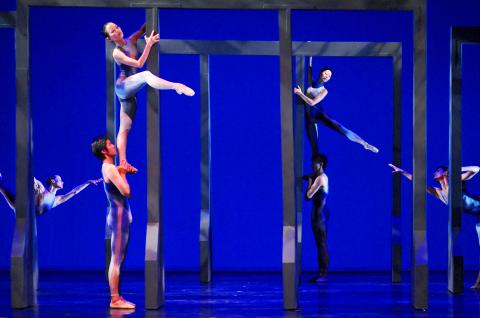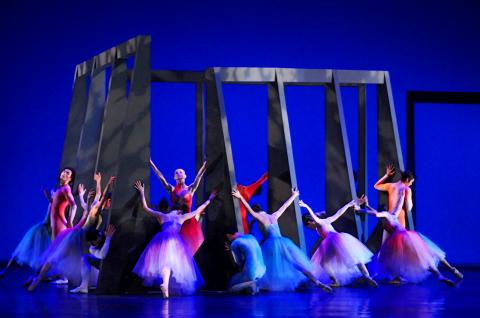It is not often that a local dance company gets to restage one of its original productions, a situation that reflects both market forces and the government’s cultural subsidy system. This is a great loss, both for audiences and a company’s performers because it robs them of a chance to revisit a work and have new dancers tackle the roles.
Building a repertoire is crucial for a company’s development and something that Tainan-born choreographer Allen Yu (余能盛) feels very strongly about.
“Taiwanese are always throwing things away ... you need a repertoire for dancers and the public. Some of my pieces are in the repertories [of companies] in Germany, the Czech Republic, but no other company keeps a repertoire in Taiwan outside of Cloud Gate [Dance Theater (雲門舞集)],” Yu said in a telephone interview last week.

Photo Courtesy of Sandy Ouyang
So Yu jumped at the chance to revise one of his works for the Tainan Municipal Cultural Center, which named Yu its first artistic director last year.
The center wanted him to do a big ballet this year, but he told them he did not have the time to create two new ballets, having organized the Museum Night, Opera Highlights (博物館之夜‧歌劇選粹) concerts in June for the Tainan Arts Festival and the Chimei Museum, which included two short dances.
So center officials picked Yu’s 2010 production, The Door (門), for the Chamber Ballet Taipei (台北室內芭蕾), which was renamed Formosa Ballet (福爾摩沙芭蕾舞團) last year.

Photo Courtesy of Sandy Ouyang
Yu said reviving The Door gave him a chance to “clean it up” and expand the cast to 30 dancers, including a larger contingent of males.
“It is one of my personal favorites of the about 30 big ballets that I have done so far,” he said. “I’m still not 100 percent satisfied, I can’t say that, but I’m happy. I really enjoy doing this piece.”
Yu brought back dancers Bogdan Canila and Cristina Dijmaru, soloists with the Bucharest National Opera Ballet who were so memorable in Yu’s 2013 Swan Lake, for the leading roles.
“Christine, she is great. She is younger than Nadja Saidakova from Deutsch Oper Berlin [who starred in the 2010 show], who was in her 40s, so I changed the choreography in the solo for her. Christine has beautiful technique, beautiful feet. She got married last year, I told her she is now different, really a woman,” Yu said.
One of the hallmarks of Yu’s productions is the use of live music. The Evergreen Symphony Orchestra (長榮交響樂團) will be led by German conductor Gernot Schmalfuss, but Yu warned that audiences this weekend will not enjoy the full effect of the music — Italian composer Nino Rota’s La Strada suite and Sergei Rachmaninoff’s Symphonic Dances — because the New Taipei City Arts Center’s theater is so small.
“With a double timpani and a piano, the space is so tight, so we had to go with a smaller, upright piano [instead of a grand piano]. However, the Hsinchu and Tainan theaters have more space,” Yu said. “I hope next year I can get a bigger place in Taipei to do a show.”
A two-act ballet, divided by both the extremely different scores and styles of choreography, The Door is about the doorways of our lives and what they lead to: jobs, love, tragedy, happiness. They serve as the turning points that frame our lives.
A collection of 12 large moveable door frames make up the starkly simple set, their strong clean lines providing a visual and a physical counterpoint to the dancers’ pliable bodies.
Performance notes
WHAT: The Door
WHEN: Tomorrow at 7:30pm, Sunday at 3pm
WHERE: New Taipei City Arts Center (新北市藝文中心演藝廳), 62 Jhuangjing Rd, Banciao District, New Taipei City (新北市板橋區莊敬路62號)
ADMISSION: NT$400 to NT$2,000; tickets available online at www.artsticket.com.tw, convenience store ticketing kiosks and at the door
ADDITIONAL PERFORMANCES: Tuesday at 7:30pm at the Performance Hall of the Hsinchu County Cultural Affairs Bureau (新竹縣文化局演藝廳), 146 Siancheng 9th Rd, Jhubei City, Hsinchu County (新竹縣竹北市縣政九路146號); Aug. 13 at 7:30pm at the Taichung Chungshan Hall (台中中山堂), 98 Hsuehshi Rd, Taichung City (台中市學士路98號); and Aug. 20 at 7:30 and Aug. 21 at 3pm at the Tainan Municipal Cultural Center (臺南文化中心演藝廳), 332, Chunghua East Rd Sec 3, Greater Tainan (臺南市中華東路3段332號). Ticket prices and purchase points as above.

This month the government ordered a one-year block of Xiaohongshu (小紅書) or Rednote, a Chinese social media platform with more than 3 million users in Taiwan. The government pointed to widespread fraud activity on the platform, along with cybersecurity failures. Officials said that they had reached out to the company and asked it to change. However, they received no response. The pro-China parties, the Chinese Nationalist Party (KMT) and Taiwan People’s Party (TPP), immediately swung into action, denouncing the ban as an attack on free speech. This “free speech” claim was then echoed by the People’s Republic of China (PRC),

Exceptions to the rule are sometimes revealing. For a brief few years, there was an emerging ideological split between the Democratic Progressive Party (DPP) and Chinese Nationalist Party (KMT) that appeared to be pushing the DPP in a direction that would be considered more liberal, and the KMT more conservative. In the previous column, “The KMT-DPP’s bureaucrat-led developmental state” (Dec. 11, page 12), we examined how Taiwan’s democratic system developed, and how both the two main parties largely accepted a similar consensus on how Taiwan should be run domestically and did not split along the left-right lines more familiar in

As I finally slid into the warm embrace of the hot, clifftop pool, it was a serene moment of reflection. The sound of the river reflected off the cave walls, the white of our camping lights reflected off the dark, shimmering surface of the water, and I reflected on how fortunate I was to be here. After all, the beautiful walk through narrow canyons that had brought us here had been inaccessible for five years — and will be again soon. The day had started at the Huisun Forest Area (惠蓀林場), at the end of Nantou County Route 80, north and east

Specialty sandwiches loaded with the contents of an entire charcuterie board, overflowing with sauces, creams and all manner of creative add-ons, is perhaps one of the biggest global food trends of this year. From London to New York, lines form down the block for mortadella, burrata, pistachio and more stuffed between slices of fresh sourdough, rye or focaccia. To try the trend in Taipei, Munchies Mafia is for sure the spot — could this be the best sandwich in town? Carlos from Spain and Sergio from Mexico opened this spot just seven months ago. The two met working in the